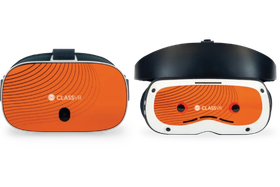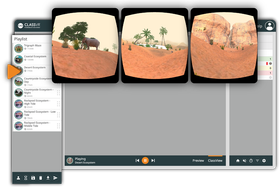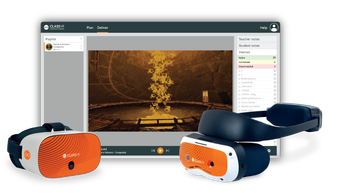
Virtual Reality for Education
Engaging VR and AR Educational Content for Students of all Ages
Virtual Reality for Students of All Ages
Introducing a whole new concept in educational technology: a ‘standalone’ Virtual Reality headset complete with a unique student-friendly interface, gesture controls, embedded educational resources and simple-to-use teacher controls. ClassVR is a groundbreaking new technology designed to help raise engagement and increase knowledge retention for students of all ages.

Pre-school
Early education is all about learning through experience.
Find out how your youngest students can benefit from immersive 360 environments, used to enhance, impact and complement the real-world exploration and play that builds a solid foundation in the pre-school years.

Primary School
ClassVR brings the whole curriculum to life for younger learners. Pupils can step inside a rainforest, walk among dinosaurs, or explore the solar system, all from their classroom.
These shared experiences enhance imagination, improve vocabulary, and help children understand complex ideas in a way that feels real and memorable.

High School
For older students, ClassVR supports deeper learning, critical thinking, and enquiry-based education.
Virtual field trips allow learners to explore historical sites, scientific environments, or cultural landmarks, building context and empathy. By making abstract or distant concepts tangible, VR helps teachers capture attention and improve knowledge retention.
.jpg)
Further Education
Further education providers can use ClassVR to deliver vocational training, technical demonstrations, and workplace simulations.
Learners can practise skills in a safe, controlled environment, whether it’s exploring engineering processes, medical scenarios, or creative design. This immersive approach prepares students for future careers while boosting confidence and engagement.
.jpg)
Higher Education
In higher education, ClassVR supports research, advanced study, and professional preparation.
Students can engage with complex models, simulations, or environments that would otherwise be inaccessible. It enables universities and colleges to innovate in teaching, making learning more interactive, collaborative, and impactful across disciplines.

Multi Academy Trust
ClassVR provides trusts with a scalable, cost-effective solution that can be deployed consistently across multiple schools.
Shared resources, teacher training, and centralised management make it easier to maintain quality while allowing each school to adapt VR content to suit their learners. This consistency strengthens collaboration and supports improvement strategies.

SEND Education
For learners with special educational needs, VR provides safe, multi-sensory experiences that are engaging and accessible.
ClassVR allows teachers to personalise content, reduce barriers, and create calming or stimulating environments tailored to individual needs. This helps build confidence, communication skills, and active participation in learning.

Higher Education
ClassVR enables governments and education ministries to drive large-scale transformation across entire regions or nations.
With scalable deployment, curriculum-aligned content, and centralised management, VR empowers ministries to deliver innovative learning consistently while supporting teachers with training and resources. It’s a future-ready solution that aligns with policy goals and modernises classroom teaching.

Industry
Beyond education, ClassVR is a powerful tool for workforce development and professional training.
Organisations can create immersive simulations for technical skills, safety protocols, and soft skills development, reducing risk while improving learning outcomes. VR enables industries to prepare employees with hands-on, practical experience that translates directly into workplace performance.
.jpg)
International Schools
ClassVR has been rolled out to international schools across the globe to enhance education.
Read our case studies from Prague British International School to the Chinese International School of Hong Kong to learn about the impacts of Virtual Reality on education.
Interested in VR for Education?
Our global team is here to help with your enquiry
Includes with ClassVR

Headsets
Ergonomically designed VR & AR headsets built specifically for education.

Immersive Content
Access thousands of curriculum-aligned
resources in our Eduverse libraries.

Classroom Management
The ClassVR Portal is fully integrated with every ClassVR headset. Giving educators real-time visibility and control.
.png)
Training & Support
Technical and educational teams take teachers from set-up through training and beyond.
.png?updatedAt=1758536654890)
Safe Storage & Charging
Rugged, lockable cases with built-in charging keeps devices safe and lesson-ready.

Device Management
Simplify school IT with ClassVR, centralised device management, remote monitoring and analytics in one platform.
Frequently Asked Questions
Why is VR important for learning?
Virtual Reality (VR) is important for learning because it creates immersive, interactive experiences that help students understand complex concepts in ways traditional methods cannot. Instead of just reading or watching, learners can experience lessons as if they were really there.
Key reasons why VR matters in education:
Encourages Collaboration – Many VR platforms let students learn and solve problems together in shared virtual spaces.
Increases Engagement – VR captures students’ attention and makes lessons more exciting.
Improves Retention – Research shows people remember information better when they experience it in 3D environments.
Supports Experiential Learning – Students can practice skills in realistic simulations, such as science experiments, language practice, or historical site visits.
Enhances Accessibility – VR makes it possible to “travel” to places or scenarios that would otherwise be too costly, dangerous, or impossible.
How do teachers use VR in schools?
Teachers use Virtual Reality (VR) in schools to create immersive learning experiences that go beyond textbooks and videos. With VR headsets and apps, they can bring lessons to life and make abstract concepts easier to understand.
Common ways teachers use VR in classrooms:
Skill Training – Teachers use VR to let students practice real-world skills, such as public speaking, coding, or vocational training.
Virtual Field Trips – Students can “visit” historical sites, museums, or even outer space without leaving the classroom.
STEM Learning – VR simulations let students explore anatomy, chemistry labs, or physics experiments in a safe, hands-on way.
History and Social Studies – Learners can step into different time periods, observe events, and interact with historical environments.
Language Learning – VR allows students to practice speaking in realistic settings, like ordering food in a virtual café or traveling in a foreign country.
Special Education Support – VR provides personalized, interactive experiences to help students with different learning needs.
Does VR improve student engagement and motivation?
Yes, Virtual Reality (VR) can significantly increase student engagement and motivation in the classroom. By creating immersive, interactive experiences, VR transforms learning from a passive activity into an active, hands-on process.
How VR boosts engagement and motivation:
Personalized Experiences – VR can adapt to each student’s pace and interests, keeping them motivated to continue learning.
Immersive Experiences – Students feel “present” in virtual environments, which captures attention better than traditional lessons.
Gamified Learning – Many VR apps use game-like challenges and rewards, encouraging students to participate and achieve goals.
Interactive Learning – Students manipulate objects, conduct experiments, or explore virtual worlds, which makes learning more engaging.
Safe Risk-Taking – VR allows students to experiment and learn from mistakes in a controlled, virtual setting, reducing fear of failure.
Can VR improve knowledge retention in students?
Yes, Virtual Reality (VR) can significantly improve knowledge retention. By immersing students in interactive, realistic environments, VR engages multiple senses and promotes active learning, which helps information stick longer compared to passive methods like reading or watching videos.
How VR boosts retention:
Contextual Understanding – Concepts are taught within realistic contexts, making them easier to remember.
Experiential Learning – Students “learn by doing,” which strengthens memory.
Interactive Simulations – Practicing skills in VR mirrors real-life experiences.
Emotional Engagement – Immersive experiences create emotional connections that enhance recall.
Repetition Without Risk – Learners can repeat scenarios safely to reinforce knowledge.